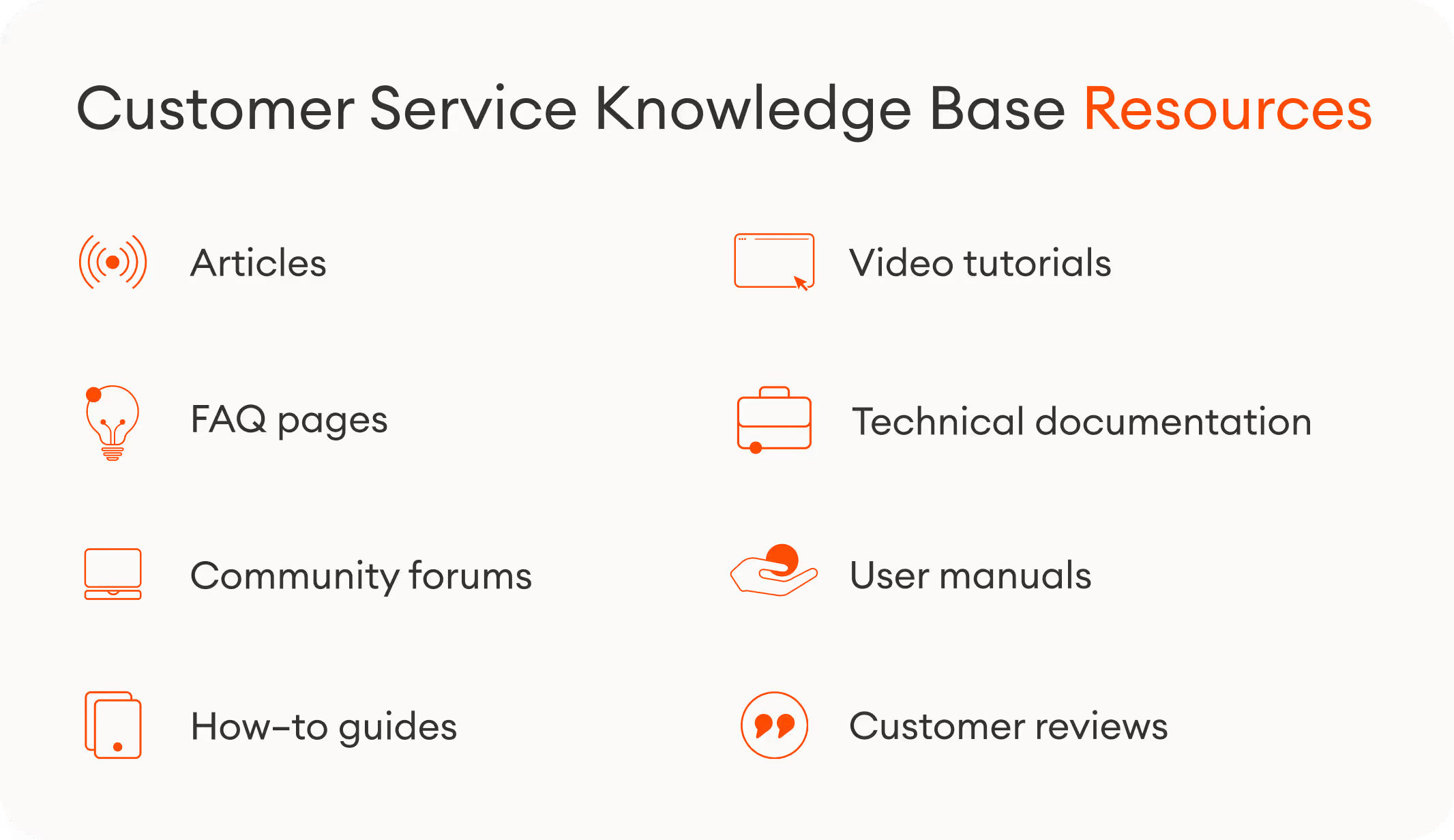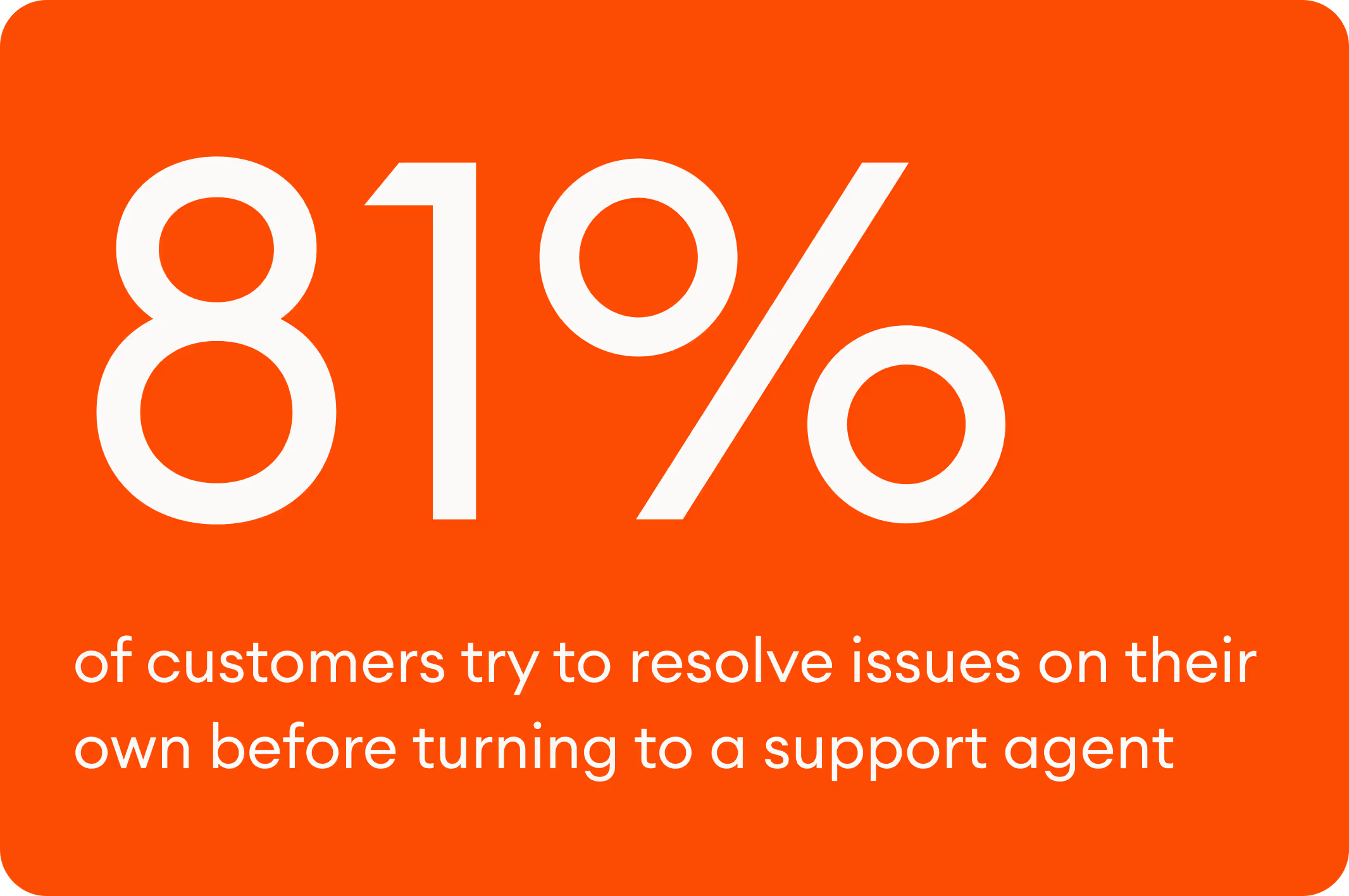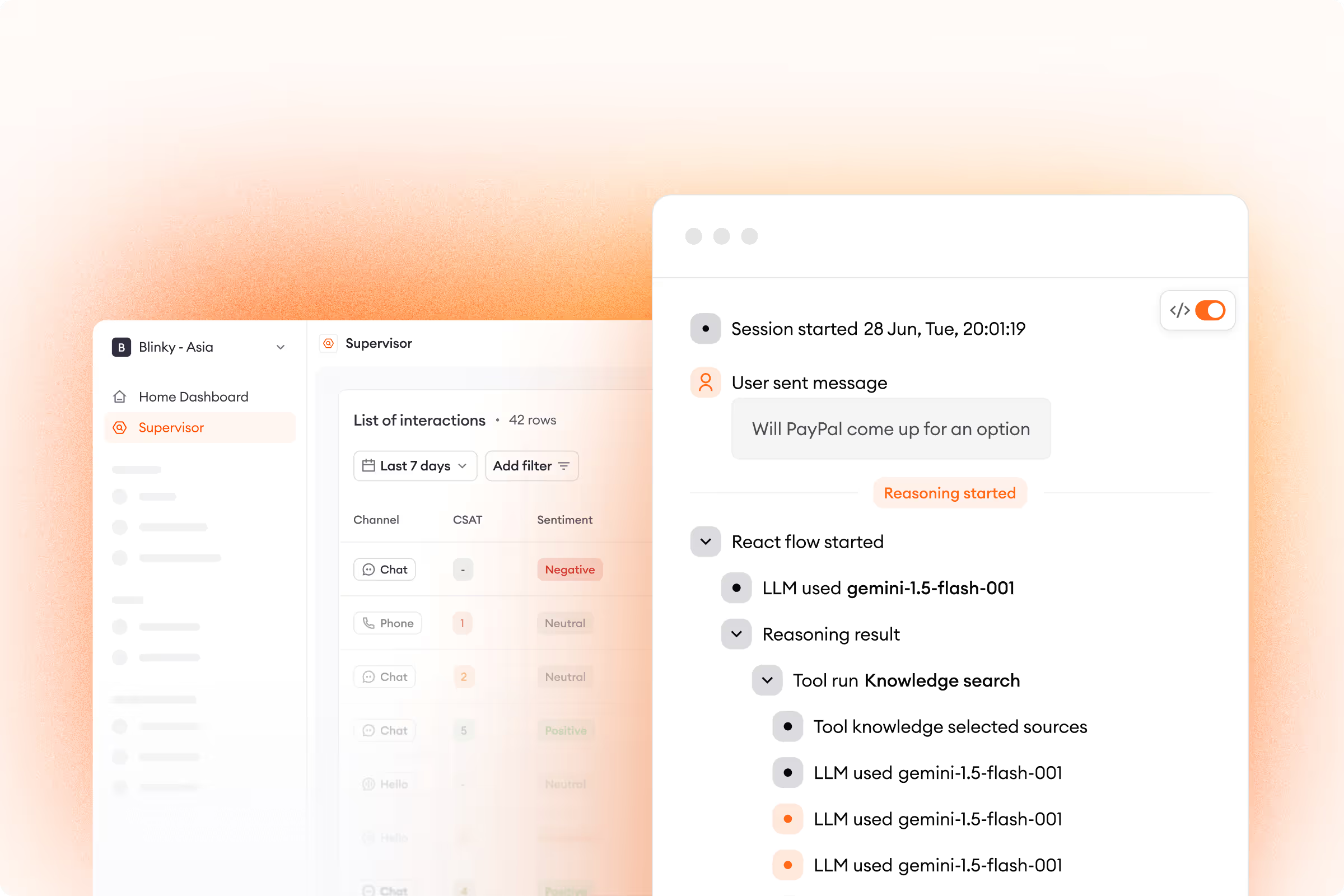In a world where digital interactions dominate, providing effective customer service can be the determining factor between building customer loyalty and settling for one-off purchases.
A robust customer service knowledge base is just what a company needs to deliver this high-quality service.
What is a knowledge base, and how do you set one up to effectively eliminate your ticket backlog?
This article delves into these topics and more to reveal how businesses can use their own knowledge base to elevate the entire customer experience.
What is a customer service knowledge base?
A customer service knowledge base (CSKB) is a centralized collection of information about a company’s products, services, and policies. Customers can use this wealth of information to get quick answers to their problems or questions.
Think back to when you experienced a glitch with any of your favorite tech gadgets. Maybe you first attempted to find a solution through a search engine before reaching out to customer support. If your search led you to any resources from the producers themselves, then you tapped into their knowledge base.
A well-structured knowledge management system noticeably cuts down time spent scouring through generic answers or unhelpful forums. Instead, users get specific solutions tailored to their unique issues right at their fingertips. A knowledge base can be a static, standalone resource or something that feeds your automation tools, like a customer service chatbot.
Here are the top subcategories businesses can include in a customer service knowledge base:

Articles
Clear and concise knowledge base articles quickly eliminate confusion by giving customers essential details in an easily digestible format. They provide in-depth insights into specific topics that allow users to understand complex subjects or features and make more informed decisions on customer issues as diverse as pricing, fixing a product, or completing a purchase.
Frequently asked questions (FAQ pages)
FAQs address a business’s most common questions upfront, giving shoppers shorter answers to a wide range of queries. For basic info, customers can quickly check out an FAQ page without having to extensively search through other pages.
How-to guides
How-to guides give customers step-by-step instructions on a specific task or process. Adding relevant pictures or screenshots to your guides makes them more accessible, as customers can regularly check if they’re following instructions accurately.
Video tutorials
Visual aids like videos are helpful when explaining how to troubleshoot or successfully complete a process step-by-step. They allow companies to walk customers through complicated issues in a more engaging way than text alone.
Technical documentation
More technical documents provide customers with comprehensive knowledge about a product. They’re also an opportunity to explain complex processes or define technical terms in simple language that even beginners can understand without needing additional searches.
User manuals
Physical manuals are all too easy to lose. When companies make digital ones accessible online, they’re letting customers know the official source of product features and usage guidelines is always a click away.
Community forums
Community forums provide a platform for users to engage with one another, share experiences, and seek advice. Peer-to-peer interaction lets customers crowdsource solutions and troubleshoot issues collaboratively.
PRO TIP: Not every element of your knowledge management system needs to be customer-facing. An internal knowledge base can be a useful tool for a customer support team when helping users solve their problems.
Why is a customer service knowledge base important?
A customer service knowledge base can be a valuable asset for businesses. In fact, customers prefer knowledge bases over all other support channels.
When used successfully, a knowledge base empowers customers by providing immediate solutions to common problems. The answers are all there — it’s just a matter of customers finding them. A CSKB alleviates pressure on customer support teams as users now have the tools necessary to troubleshoot and diagnose minor problems without assistance from service representatives.
And especially in the increasingly competitive ecommerce space, having a good knowledge base isn’t just an extra nice-to-have feature for businesses — CSKBs are rapidly becoming an essential resource. A well-managed knowledge base can contribute to a company’s success by improving customer service efficiency, bringing shoppers a smoother experience, and giving a much-needed boost to the bottom line.
The benefits of a customer service knowledge base
Self-help articles and how-to guides can be quite valuable for businesses, and their usefulness is amplified when used to power knowledge base tools like a chatbot. Knowledge bases offer the following benefits:
1. Enhanced self-service
Having a well-stocked knowledge base allows for improved self-service options for customers who prefer resolving problems at their own pace.
And we’re not talking about some niche group — 81% of customers try to resolve issues on their own before turning to a support agent. If you can’t offer the self-service that customers expect, they’ll grow frustrated and possibly abandon their purchase — before you ever get a chance to talk to them.

To keep customers happy, it’s important to continuously update your self-service knowledge base to ensure it has the latest information, policies, and content.
2. Improved agent efficiency
With more queries being addressed via the knowledge base, fewer tickets land in your support queue, reducing agent workload and improving average response times for more complex issues that require a service rep.
Repetitive tickets easily drain a support team’s time and resources that could otherwise be invested elsewhere. A knowledge base acts as your first line of defense against these incoming queries and a high ticket volume.
Not only does a well-equipped knowledge base give existing agents breathing room, but it also brings operational improvements by letting new customer service team members catch up quickly. New hires can use the knowledge base themselves to learn all about your products and procedures to minimize onboarding and training times.
3. Reduced support costs
Less strain on human agents translates to fewer resources required for customer management. Ultimately, this leads to significant cost savings.
With more customers finding answers from your knowledge base, the need to hire more agents goes down — including during seasonal spikes. Self-service’s time savings also cut down on operational costs across the board — agents no longer have to worry about the many back-and-forth tasks associated with answering most repetitive questions.
And by linking their knowledge base with a customer service chatbot, businesses can drive costs down even lower. AI chatbots can be fed your company’s entire knowledge base, meaning customers can quickly self-serve without searching across your website for the resources they need. A simple question in your chat widget is all it takes, and the chatbot can instantly deliver an answer or guide shoppers exactly where they need to go.
In doing so, AI chatbots handle the work of multiple agents, keeping support costs at bay.

4. Higher customer satisfaction
A well-built customer service knowledge base provides customers with quick and easy access to valuable information. Waiting for responses from support personnel is the most frustrating part of the service experience for almost 60% of customers, and a knowledge base helps keep wait times at a minimum.
By giving shoppers essential resources at their fingertips 24/7, businesses are enhancing the user experience and driving high levels of customer satisfaction. Over time, this builds up loyalty toward your brand as satisfied shoppers are more likely to return with repeat business, knowing they have your reliable knowledge base to turn to whenever needed.
Best practices for building a customer service knowledge base
When it comes to creating and managing your customer service knowledge base, here are some best practices that go a long way toward success concerning getting set up, optimizing performance, and guaranteeing continued success.
Getting set up
1. Know your target audience
To make an effective knowledge base, it’s paramount to know who you’re making it for. This isn’t just about knowing your customer base but also which of your customers are most likely to seek out your knowledge base resources.
Will you mainly cater to tech-savvy users or completely new customers? What will these shoppers need, and what questions will they have? Once you know the answers to these questions, you’ll be able to design a solution that fits your customers’ specific requirements.
2. Help your support team
A well-built CSKB does more than elevate the user experience — it also reduces your staff’s workload. Set up your knowledge base to direct customers to the relevant resources before they raise a ticket. When tickets are created, provide support agents with instant access to your library of solutions to enable them to resolve cases as quickly as possible.
Keeping customers and agents in mind when crafting your knowledge base is a solid foundation for any customer service strategy that improves both service delivery and internal efficiency.
3. Integrate your knowledge base with the right software
To maximize your CSKB’s scalability, customization, and ease of use, integrate your resources with platforms that boost your support team’s capabilities. That way, customers have more ways to find the answers they need, and if they can’t, support reps can quickly obtain the information themselves.
With live chat, ticketing, and customer relationship management (CRM) tools, support agents can access past tickets, buying history, and customer behavior patterns while interacting with customers. As a result, response times drop as hours spent on manual data-searching are saved. The customer experience improves, and shoppers can develop a sense of loyalty to your brand.
Optimizing performance
4. Link up to a chatbot
Chatbot integrations are another pathway to maintaining a good customer service knowledge base. Common queries can be funneled through chatbots, facilitating quicker resolution times while freeing up human agents for more complex issues.
This starts with having pre-programmed responses from your chatbot direct users to existing knowledge base articles. If a live agent is still needed, chatbots can still route shoppers to the most qualified representative in real time.
5. Turbocharge your knowledge base with AI
While rule-based chatbots can serve as a directory that guides customers to the right CSKB resources, AI chatbots can be trained on your knowledge base itself, meaning they can deliver answers themselves, resolving cases right there in the chat window. They even self-learn to provide more relevant responses over time.
And with the power of generative AI, these chatbots can fully simulate human conversation. Even as they access information directly from your knowledge base, they do more than simply regurgitate the data they find. They craft ultra-personalized responses to suit each customer while capturing your brand’s unique style and voice.

6. Give your knowledge base omnichannel functionality
To make your knowledge base an organic part of your customer service ecosystem, sync it with every support channel your team is utilizing. Deliver a friction-free customer experience and meet shoppers where they want, whether they reach out to you over chat, social media, SMS, and more.
The typical customer uses 3 to 5 customer service channels on a regular basis. To increase customer satisfaction, ensure users can access the same information — with the same level of effort — on multiple service channels.
7. Offer personalization features
Today’s consumers expect services tailored uniquely toward them. They appreciate when a brand recognizes their preferences and delivers personalized experiences based on them.
Knowledge base resources aren't immune to this demand for individualized content, and meeting this expectation has immense potential for enhancing the user experience. Create content that’s dynamic, like resources that change based on variables like browsing history or user location.
For instance, a shopper in California can view regional troubleshooting instructions that differ from what users in New York or London would see.
This personalization amplifies the relevance of your knowledge base as each customer feels they’re reading information written specifically for them.
Guaranteeing continued success
8. Regularly add, review, and update resources
As your business evolves, so will your products, services, and, in turn, your customers' needs. And an outdated customer service knowledge base can often do more harm than good.
Companies should periodically prepare new articles — and update existing ones — to help customers stay up to date with the latest information. Use a clear schedule to conduct regular audits of your knowledge base content. Build customer trust by making sure your resources are fresh and relevant assets that continue to provide value.
9. Measure knowledge base performance
Gauging your CSKB's effectiveness doesn’t have to be a matter of guesswork or intuition. You can use metrics to track how useful your knowledge base actually is.
Parameters such as article views and your most popular search terms highlight how well your resources are meeting customer needs. Your most telling metrics, though, just might be your knowledge base’s impact on support tickets and response times. Drops in ticket volume and response times are a sure sign that customers and agents are turning to your resources to handle issues successfully.
10. Solicit customer feedback
To keep your knowledge base optimized down the road, encourage your customers to give feedback on your content. No one understands what users need better than the customers themselves, so open dialogue and customer reviews offer tremendous insight into how you might improve your knowledge base resources.
Suggestions can be automatically collected and analyzed to help customer service teams see what comments shoppers are sharing and make modifications where needed. You’ll be able to maintain a refreshed, flexible knowledge base that consistently addresses your customers’ top concerns.
11. Make your knowledge base scalable
The best CSKBs assist an unlimited number of customers and promote company growth — even as a business expands abroad. Multilingual support is a must-have for anyone looking to serve an international audience.
Thankfully, you don’t need to employ an army of translators or local support teams to gain a global reach. Multilingual customer service solutions can read and translate your knowledge base into hundreds of languages, placing immediate answers at the fingertips of an increasingly wider customer base.
Bonus: a knowledge base for your agents
A customer service knowledge base doesn’t have to be only for customers — it can help out support representatives as well. Here are some quick tips for optimizing your knowledge base from your agents’ point of view:
1. Keep it simple
You know you’ve got to make your knowledge base intuitive for shoppers, but the same holds true for customer service reps. If reps are struggling to hunt down the right data, your knowledge base could be counterproductive and actually eat up more time rather than saving it. Build out a user-friendly CSKB that agents will want to use, enhancing the agent experience along the way.
2. Communicate openly
You want your agents to know your knowledge base front and back — it should act as your source of truth that guides them to the right answers. Ensure you’ve got knowledgeable employees by training them thoroughly on your self-service assets, but make it simple for them to know where to turn if they have questions. Foster a culture of openness and collaboration so customer service agents can become experts on your knowledge base and help one another out when needed.
3. Develop workflows
Customer queries don’t always have a simple answer. For complex cases, build out clear processes for agents to follow when assisting users. That way, agents won’t just know where to find answers in your knowledge base, but they’ll know what steps to take next. Setting up clear workflows and ready-made templates ensures agents provide consistent information and minimizes the chances of customers ever feeling lost.
Bolster your knowledge base software with AI
A comprehensive knowledge base is a valuable cornerstone for any customer support system. And automation tools can train your AI-powered chatbot on your knowledge base, delivering instant and accurate answers to customer questions directly in the chat window.

.avif)

.avif)
.svg)







